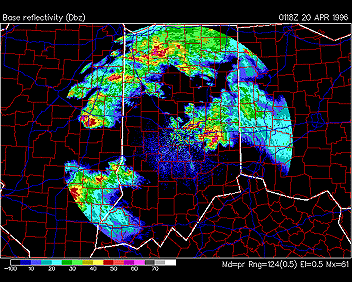
|
The word radar is an acronym from "Radio Detection and Ranging". Radar images are useful for locating precipitation. As a Magnetic Resonance Imaging (MRI) scan examines the inside of a human body, a radar examines the inside of a cloud. A radar sends a pulse of energy into the atmosphere and if any precipitation is intercepted by the energy, part of the energy is scattered back to the radar. These returned signals, called "radar echoes", are assembled to produce radar images.

The location of the colored radar echoes indicate where precipitation is falling and the various colors indicate the intensity of the precipitation through the color code in the lower left corner of the image. The example radar image above shows several strong thunderstorms moving through Illinois and Indiana on April 20, 1996. Regions of light and dark blue indicate regions of lighter precipitation while areas of red and pink indicate strong, to occasionally severe thunderstorms.
Normally, it is difficult to distinguish precipitation type on the basis of the radar reflectivity alone. Snow and light drizzle both produce radar reflectivity with about the same value. Melting snow and moderate rain also have similar values. Very high reflectivities (the grays on the scale on the image above) are always associated with hail.

Radar Basics |
|

mdr images |




